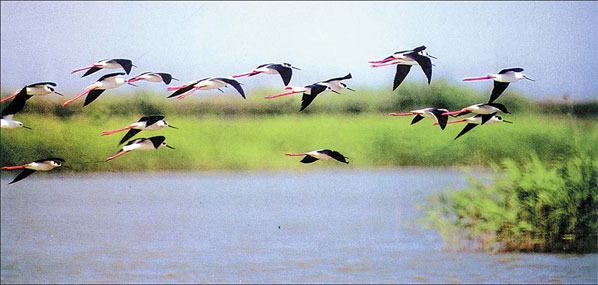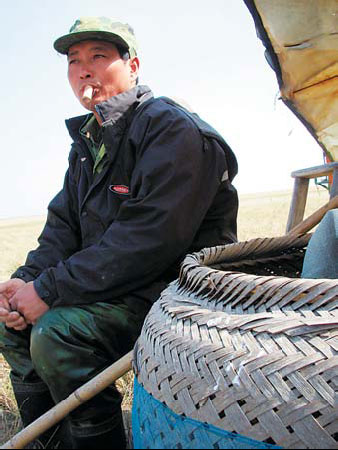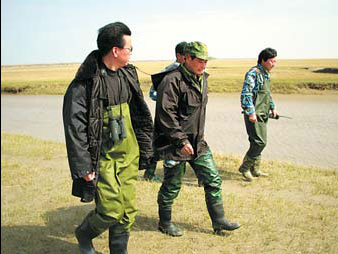Birdman of Dongtan
|
The Shanghai Chongming Dongtan National Nature Reserve is a major stopover for migrant shorebirds on the East Asian-Australian migratory shorebird flyway. File Photo |
One late-March morning, Jin Weiguo put on his rubber fishing suit and climbed on to a boat lying anchored on the broad mudflats of Chongming Island, Shanghai, with a bamboo basket, a mist net, a rope and a black umbrella.
For the next two months, the boat will be his temporary home. As tens of thousands of shorebirds make a stop at the wetlands at the mouth of the Yangtze River on their long hard journey from Australia, New Zealand and Southeast Asia to Western Siberia, it is time for Jin and his colleagues to launch their busiest spring bird-catching season.
Everyday, from early morning to 3 pm, he will deploy his mist net, place several wooden birds - the lures -behind it, hide behind his umbrella, start imitating the different calls of the shorebirds by blowing his bamboo whistle, and wait for his targets to fall into his trap.
At 49, however, Jin is not a poacher even though he has been hunting birds like this from the age of 12. Working with the Shanghai Chongming Dongtan National Nature Reserve since 2001, he catches birds only for the reserve's regular operations of banding shorebirds.
|
Jin Weiguo blows a bamboo whistle to lure shorebirds. |
"Located on the East Asian-Australian migratory shorebird flyway - one of eight major bird migration routes in the world - Dongtan (wetland) is the first stopover place for many birds heading north in the spring and their last food supply station when flying back to their wintering ground in the southern hemisphere in the fall," Song Guoxian, director of the reserve, tells China Daily. "To chart their migration patterns, we need to catch some of the passing waders and tag metal rings or colorful bands on their legs. This is the universally-accepted method of banding."
Founded in 1998, the reserve on the country's third largest island, after Taiwan and Hainan, started the banding exercise in 2001. It rings an average of 6,000 birds during the two banding seasons of the year. "The spring season, from late March to mid-May, is shorter and busier as the shorebirds hurry north for better nesting spots. While flying home in the fall, the birds have already bred and their journey south is often twice as long as the flight north," Song says. "A dozen of our reserve's managers and patrolmen will handle the birds trapped by Jin and another expert catcher - weighing, measuring and examining them for molt."
The reserve has a database for each banded bird and shares information about the banded birds and bird recoveries with the National Bird Banding Center of China and similar organizations worldwide.
"Last year I caught 4,000 birds for the reserve," Jin Weiguo says. "This year, I expect to catch more."
Meanwhile, ordinary families in Shanghai can visit the wetland, watch the banding and even assume the responsibility for the care of some banded shorebirds, under a program launched by the reserve last year.
"For 100 yuan ($14) per person and 200 yuan for a banded bird, a Shanghai family can enter the reserve's core area, learn about our banding operation and get a certificate for their help," the director says. "We offer the program only at the weekends during the banding seasons. We provide guides, transportation within the reserve, fishing suits and binoculars to visitors. The project is not aimed at earning money but at environmental education."
Last year, more than 30 families earned the certificate by joining the program.
The banding operations and the program are just part of Song and his colleagues' efforts to develop the reserve into one of the country's best-preserved nature reserves. "Working at one of the most important wetlands in East Asia and Shanghai's largest wildlife's sanctuary, our major work is to better protect the wetland and the wildlife relying on it," Song says.
Covering an area of more than 240 sqm, the Dongtan wetland, like Chongming Island, is formed by the mud and sand silt carried by the Yangtze River as it drains into the East China Sea. The extensive fresh and salt water marshes, tidal creeks, and inter-tidal mudflats at the eastern end of Chongming Island support large numbers of birds and a rich variety of fish, crustacea, mud-dwelling invertebrates, water plants and even tiny plankton. So far, a total of 290 species of birds have been observed at the Dongtan wetland, 20 of which are endangered species, as per the China Species Red List. In 2002, the Dongtan wetland joined the Convention on Wetland of International Importance Especially as Waterfowl Habitat - short for the Ramsar Convention - and was designated world Ramar Site 1144.
For better protection, Song says, the reserve has strengthened its management on fishing, seafood collection, reed harvesting and cattle herding. "Locals who want to enter the reserve need to apply for special permits," he says. "This helps us keep a close eye on human activities in the reserve."
This year, 35 permits have been issued to local fishermen and shrimp collectors. The quota under each permit is 1,200 kg of fish and shrimp. A special fishing net was banned as it was seen as posing a risk to the shorebirds.
Permits for clam collectors have been decreased from 71 in 2007 to 65 in 2008. Collecting clams by spading the mudflats are banned and the quota is restricted to 800 kg.
Ninety permits were issued to reed collectors, but the harvesting had to end before March 15 - when the arrival of migrating shorebirds peaks - and the transportation of reed had also to be completed before the end of March.
Only 350 heads of cattle were allowed to enter the wetland, down from 400 heads last year and 1,000 heads, several years ago.
|
Song Guoxian (left), director of the reserve, with some patrolmen. Photos by Chen Liang |
"The families in Chenjiazheng township, where the reserve is located, used to allow all of their cattle to graze in the reserve," Song says. "Grazing on the grasslands favored by the hooded cranes, the cattle had become a major threat for the endangered species' wintering at Dongtan."
By restricting access to the wetland by cattle, more than 100 hooded cranes have been found to stay longer in the reserve this year.
All of these regulations were made after consultations with the local communities, says a reserve manager. "Without the local communities' support, we cannot achieve sustainable development."
Besides, the reserve has also put special emphasis on scientific research and capacity building by cooperating with different research institutes and international conservation organizations such as The Nature Conservancy (TNC) and World Wide Fund for Nature (WWF).
Funded by the TNC China Office, for example, the reserve will send four of its 24 regular employees to Hong Kong to receive training at a local wetland reserve.
(China Daily 04/23/2008 page18)

















